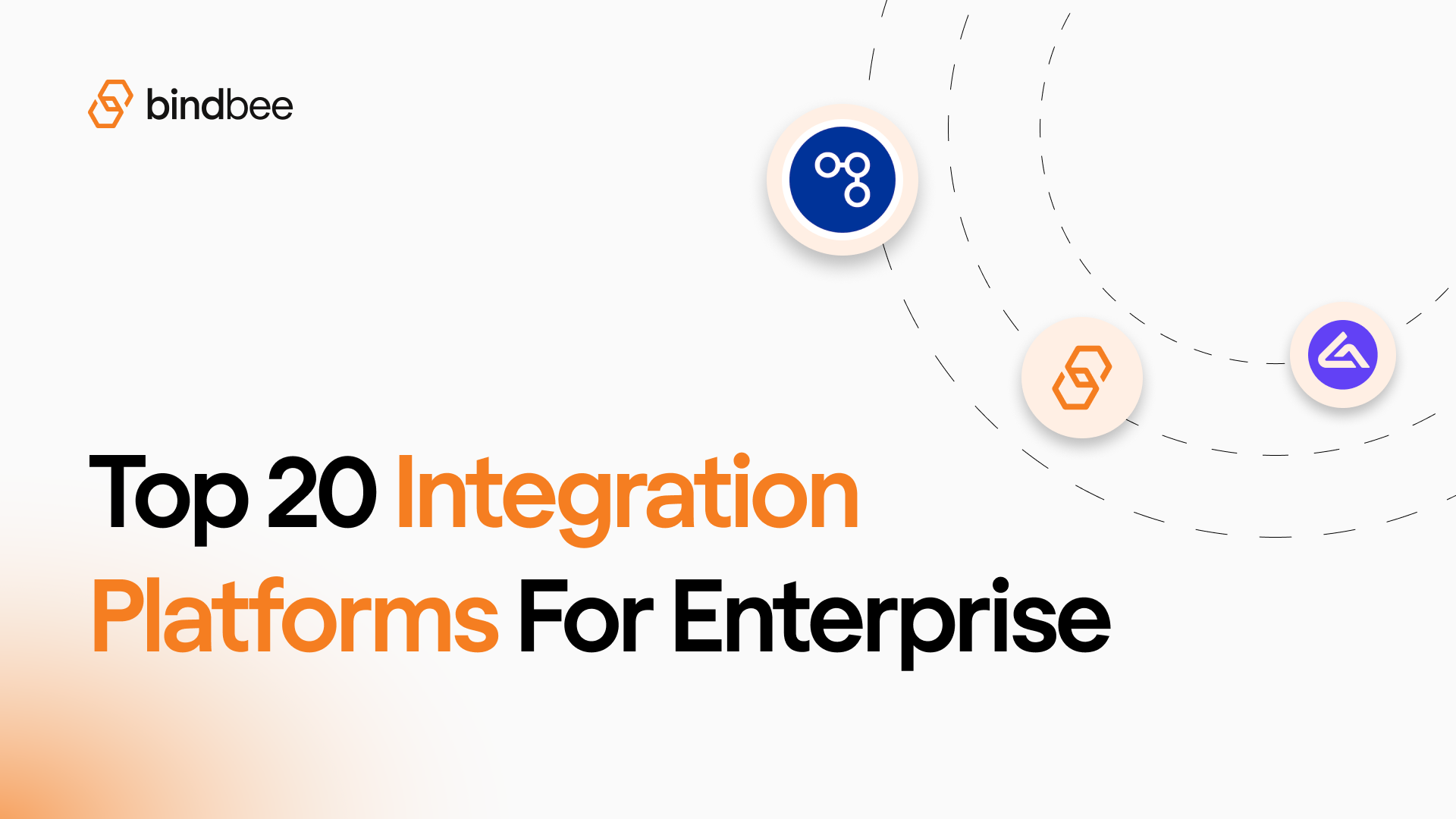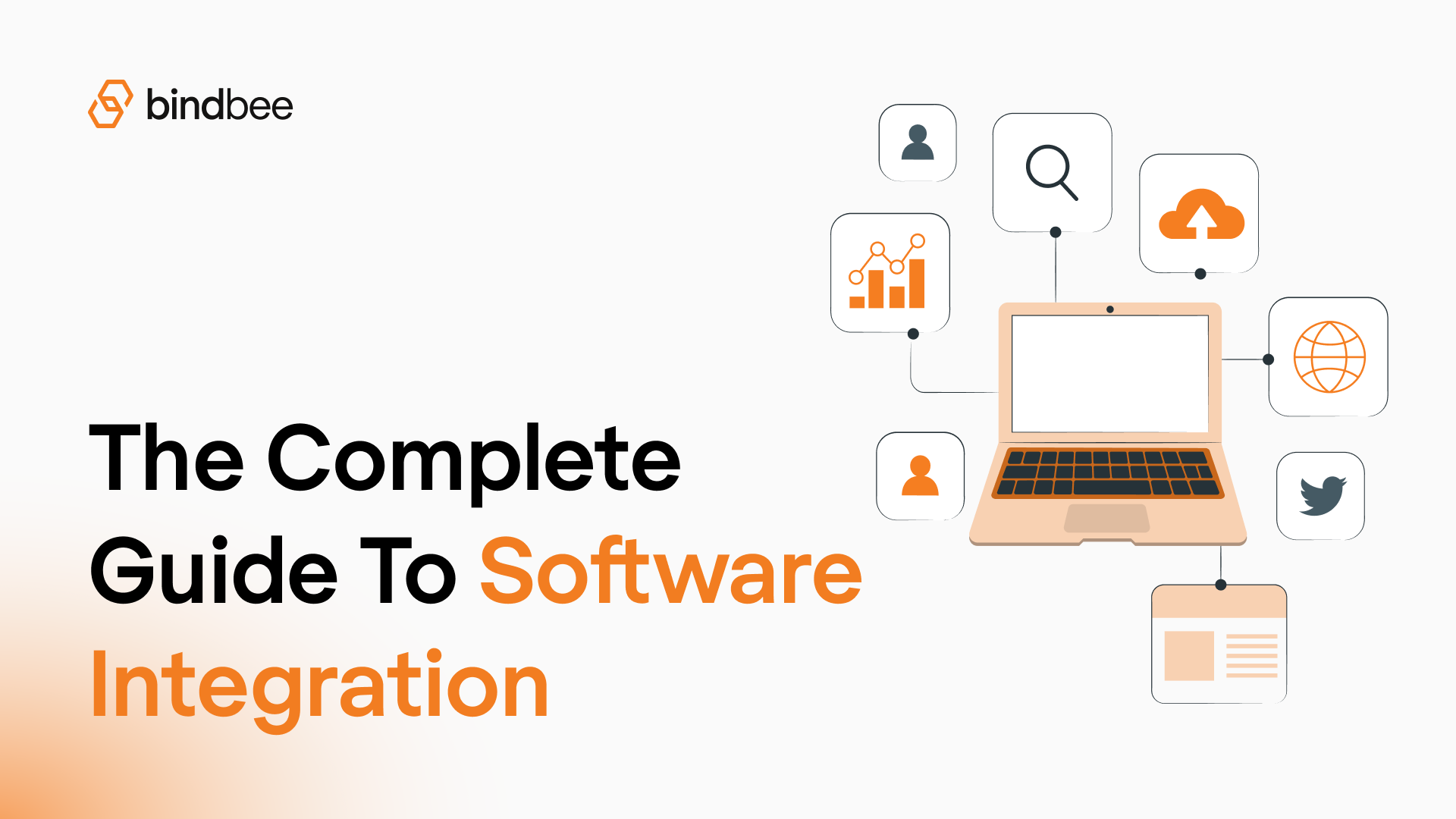Your tech stack is supposed to make life easier. HRIS, payroll, ERP, CRM—each system is top-notch on its own.
But when they don’t talk to each other?
That’s where the headaches start. You’re manually reconciling spreadsheets, chasing delayed updates, and constantly wondering if sensitive employee, customer, or financial data is actually secure.
And here’s the kicker: one small slip, an unsecured API, a misconfigured connector, or a missing audit log, can turn a routine workflow into a compliance nightmare.
Integration platforms are supposed to fix that.
They connect your apps, automate workflows, and make sure data flows securely and consistently across your systems. But for enterprises, it’s not just about automation. You need encryption, role-based access controls, audit trails, and compliance with standards like SOC 2, ISO 27001, and GDPR.
With the global iPaaS market projected to grow from $15.63 billion in 2025 to $78.28 billion by 2032 (CAGR 25.9%), it’s clear that businesses are doubling down on platforms that balance efficiency, reliability, and security.
In this guide, you’ll discover the top integration platforms for 2025 so you can choose tools that streamline workflows, save time, reduce friction, and keep your enterprise data safe.
At a glance:
- Enterprise stacks create friction. HR, payroll, ERP, and CRM systems often operate in silos, causing delays, errors, and repeated manual work. Integration platforms automate data flow and keep teams aligned.
- Platform choice matters. Low-code automation, hybrid cloud governance, and real-time API orchestration serve different needs. Pick what fits your scale and compliance requirements.
- Leading tools like Bindbee, Boomi, MuleSoft, and SnapLogic centralize integrations, automate routine tasks, and provide dashboards to monitor system health and uptime.
- Simplifies vendor oversight. Platforms consolidate connections, centralize logs, and make auditing and troubleshooting across multiple systems faster and easier.
What Are Integration Platforms?
Your enterprise IT ecosystem is complex. HRIS, payroll, CRM, ERP, and legacy applications often run on different clouds, tech stacks, and update cycles. Integration platforms help you make these systems operate as a cohesive whole. They move data, orchestrate workflows, enforce governance, and maintain security at scale.
Think of an integration platform as your control plane. It routes data, transforms formats, manages errors, and enforces security policies across systems. It reduces operational friction, prevents data silos, and frees your engineering teams to focus on innovation rather than firefighting connectivity issues.
Impact on your workflows:
- Automated, auditable data flows: Employee records, payroll data, and customer information move across systems in near real-time with encryption and compliance controls.
- Reduced operational overhead: Manual reconciliations, batch exports, and script maintenance are eliminated.
- Visibility and control at scale: Central dashboards provide insights into data health, workflow failures, and integration performance, helping you maintain governance and reduce risk.
With the right integration platform, you can ensure predictable, secure, and auditable operations across complex, multi-vendor ecosystems, giving you confidence that critical business data flows reliably and stays compliant.
Why Integration Platforms Are Critical for Enterprises
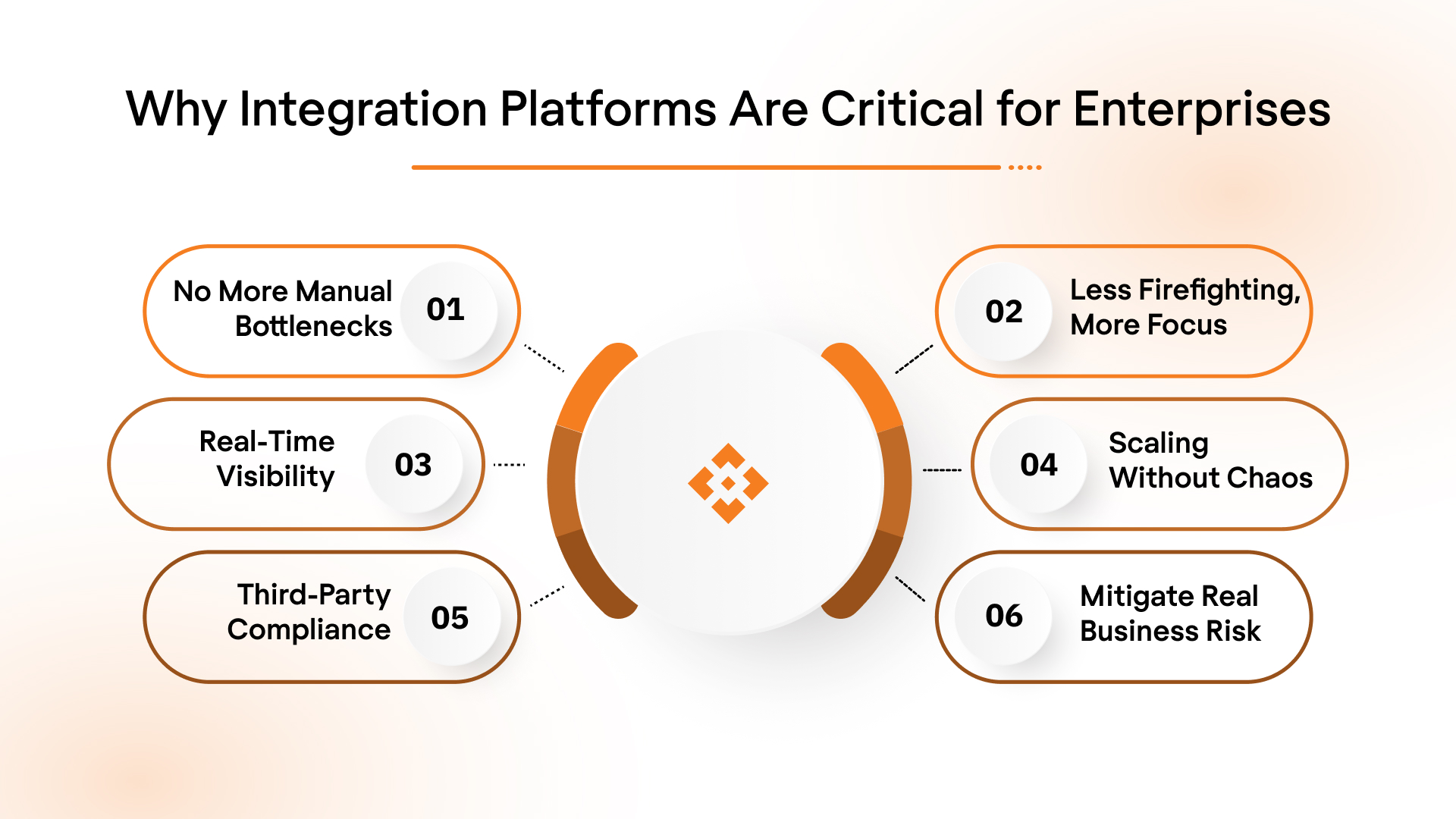
If you’ve ever managed multiple systems, you know how messy it can get. HRIS updates not hitting payroll, employee record changes delayed, and ops teams constantly chasing broken connections can be exhausting.
In large organizations, these issues multiply fast, creating friction, errors, and risk.
Using third-party integration tools introduces another layer of concern. With sensitive employee, customer, and financial data flowing through external platforms, any weak link can expose the organization to compliance violations, data breaches, and reputational damage.
Integration platforms tackle these headaches head-on. Here’s what you actually get:
- No more manual bottlenecks: Manually updating one system and then syncing across payroll, HR, or CRM is slow and fragile. Automation makes the data move accurately, every time.
- Less firefighting, more focus: Teams stop drowning in spreadsheet reconciliations, batch uploads, and repetitive syncs. That bandwidth goes straight to strategic work, process improvements, and scaling initiatives.
- Real-time visibility: When connections are scattered, it is impossible to know what is broken and where. Dashboards and alerts give you a live view of data health and workflow performance.
- Scaling without chaos: Adding a new app should not mean building 10 brittle point-to-point connections. Platforms let you expand your stack cleanly.
- Secure, compliant operations with third-party tools: Data is encrypted in transit and at rest, access is controlled, and audit trails ensure compliance with regulations such as GDPR, HIPAA, and SOC 2.
- Mitigate real business risk: Payroll mistakes, missed benefits updates, or inconsistent CRM data are not just annoying. They cost money, time, and credibility.
Standardized, automated integrations keep operations running and reduce compliance exposure.
The right platform lets your teams work faster, stay accurate, and scale confidently. You turn a spaghetti stack of apps into a smooth, auditable workflow, and that is the kind of reliability senior leadership expects.
Suggested Read: Application Integration Benefits: Boost Productivity 2025
Top Integration Platforms for All Enterprise Needs
Integration platforms come in many shapes—iPaaS, middleware, cloud connectors, and unified APIs. Each serves a different purpose, from automating data flows to connecting legacy systems with modern applications. Choosing the right platform depends on your tech stack, integration complexity, and business goals.
Below is a list of leading platforms across categories, with a quick note on where each fits best.
1. Bindbee
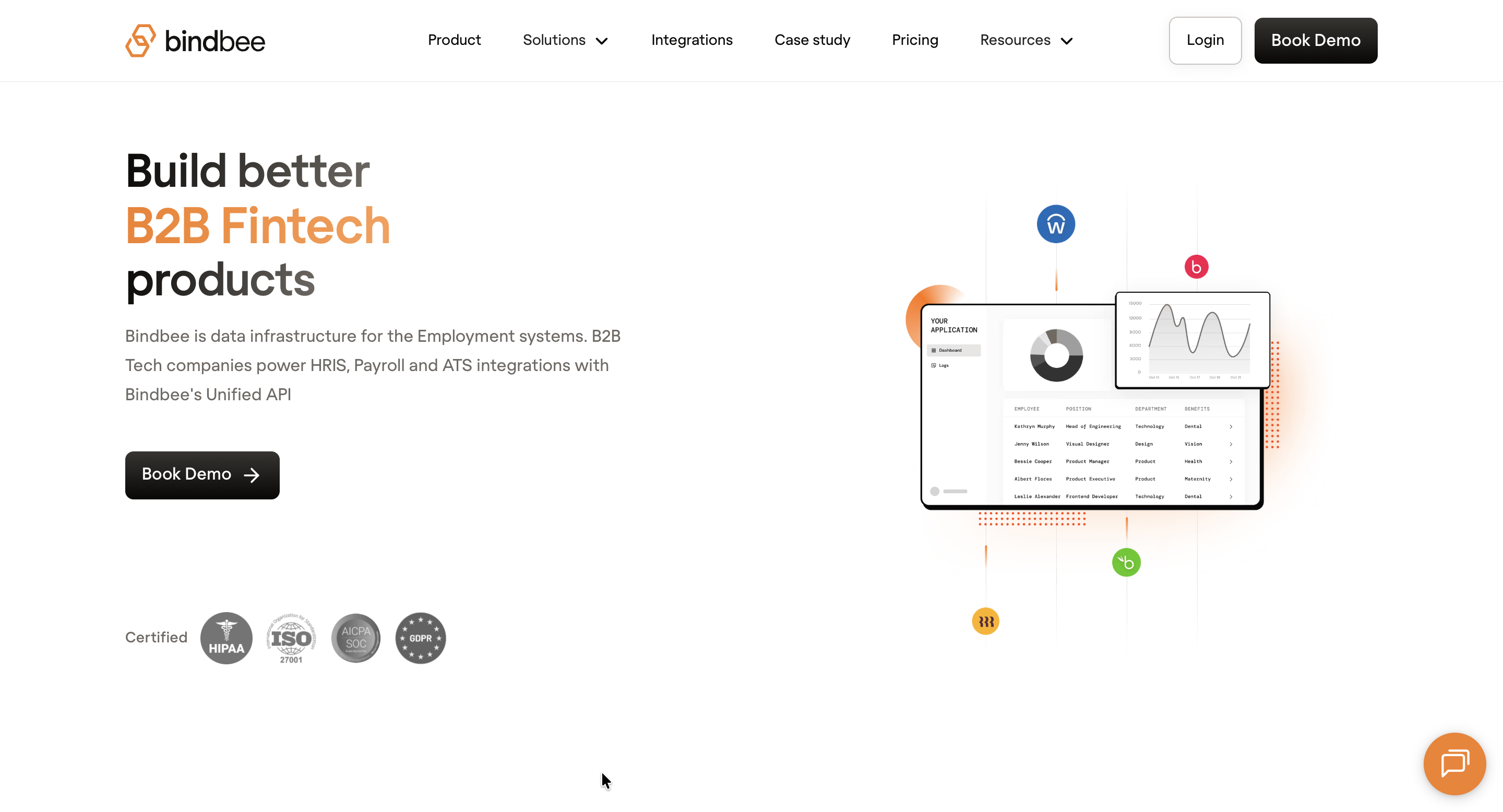
Bindbee offers a Unified API designed to simplify and scale integrations with HRIS, ATS, payroll, and other enterprise systems. Enterprises can use a single integration point to connect with over 60 HR platforms, eliminating the need for multiple point-to-point connections. This approach enables 1:many integrations, where a single data source can push updates to multiple destinations automatically, streamlining workflows and reducing engineering overhead.
With Bindbee, B2B tech companies and enterprise IT teams can implement integrations faster, monitor their health, and maintain compliance, all from a centralized platform.
Key Features:
- Unified API Access: Integrate with multiple HR systems using a single API, reducing the complexity of managing multiple integrations.
- 1:Many Integration Capabilities: Send employee, payroll, or ATS data to multiple platforms simultaneously, enabling scalable workflows without duplicating development work.
- Embeddable UI Components: Implement integrations quickly with no-code solutions, allowing for faster deployment and reduced development time.
- Real-Time Data Sync: Keep information up to date across all connected systems with frequent synchronization intervals, supporting operational accuracy and decision-making.
- Comprehensive Dashboard: Monitor integration health, access logs, and manage issues through a single, intuitive interface.
- Security & Compliance: Meets industry standards with SOC2, ISO, HIPAA, and GDPR certifications, ensuring data protection and regulatory compliance.
Best Fit For: Bindbee is ideal for HR tech enterprises and employee benefits platforms that need to manage complex multi-system HR, payroll, and ATS integrations.
2. SnapLogic
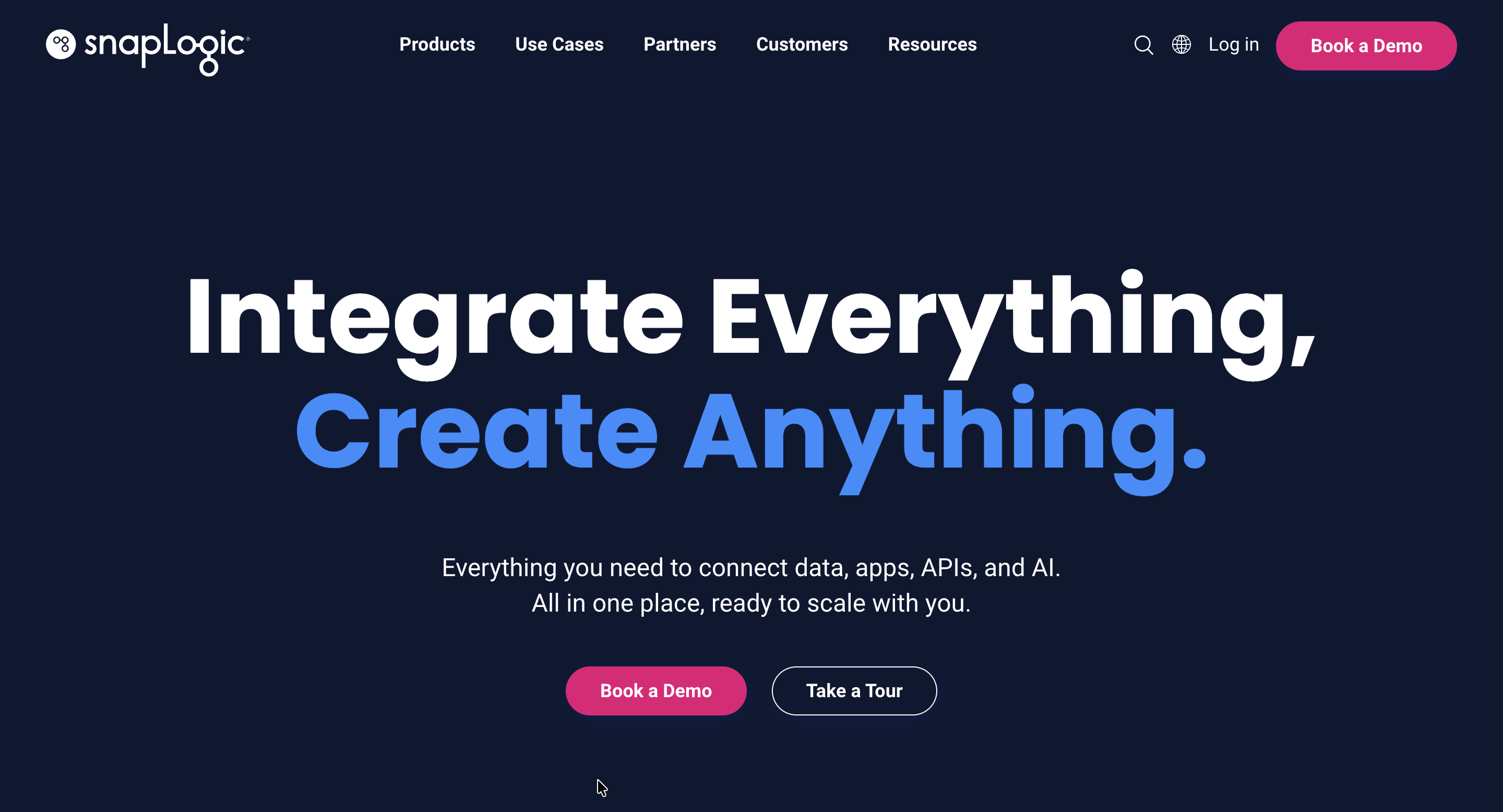
SnapLogic connects cloud data sources, SaaS applications, and on-premises business software applications, facilitating automated workflows and data synchronization.
Key Features:
- AI-Powered Integration: Utilizes artificial intelligence to optimize integration processes.
- Pre-Built Connectors: Offers a wide range of pre-built connectors for various applications.
- Real-Time Data Processing: Supports real-time data integration and processing.
Best Fit For: Enterprises needing low-code, AI-powered integrations to automate complex workflows across HR, finance, sales, and IT systems, improving operational efficiency and scaling business processes seamlessly.
3. IBM App Connect
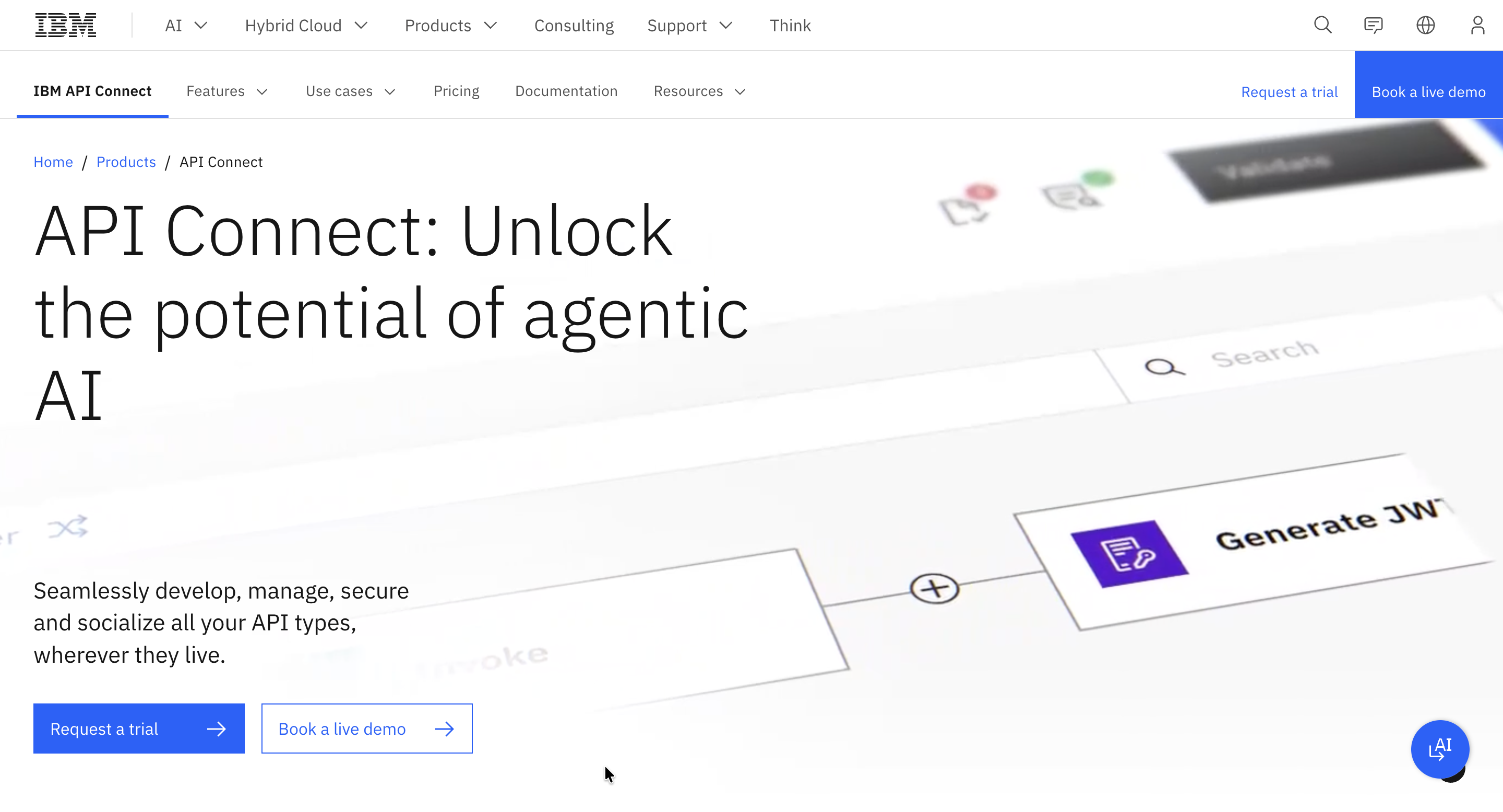
IBM App Connect links applications, data, and systems across hybrid environments, supporting APIs, event-driven workflows, and automation.
Key Features:
- Prebuilt Connectors & Templates: Accelerates integration projects.
- Hybrid Deployment: Works with cloud and on-premise applications.
- Event-Driven Automation: Responds to changes in real-time across systems.
Best Fit For: Large organizations requiring secure, scalable integrations across legacy systems, cloud apps, and APIs, especially in regulated industries where compliance and robust workflow orchestration are critical.
4. Zapier
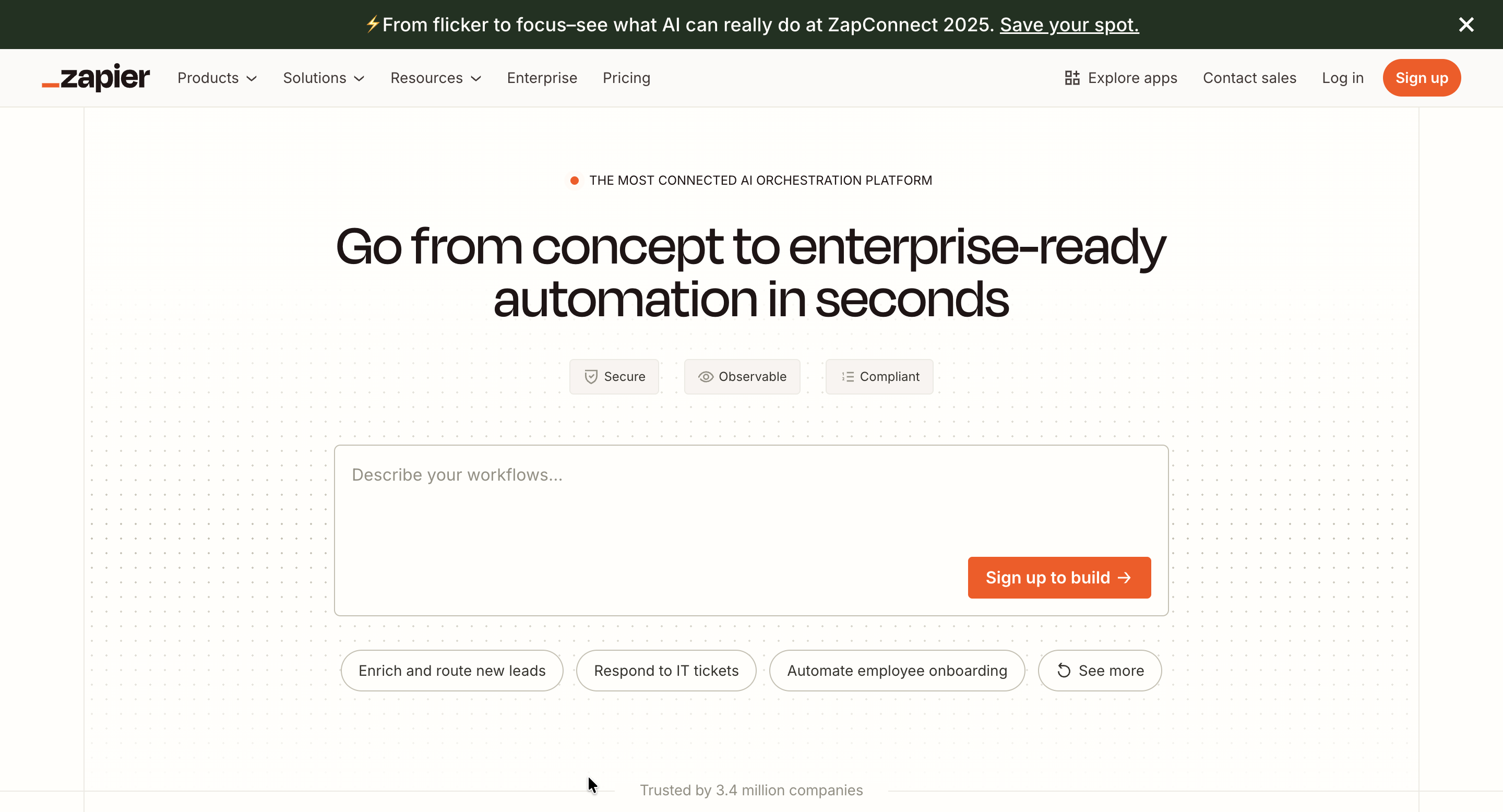
Zapier connects apps and workflows without coding, enabling businesses to automate repetitive tasks across multiple systems.
Key Features:
- No-Code Automation: Build workflows between thousands of apps easily.
- Prebuilt Connectors: Supports popular apps like Gmail, Slack, Salesforce, and more.
- Conditional Logic: Automate complex workflows with triggers, actions, and filters.
Best Fit For: Teams seeking quick, no-code automation for SaaS apps to reduce manual work, sync data, and streamline everyday workflows without heavy IT involvement.
5. Integrate.io
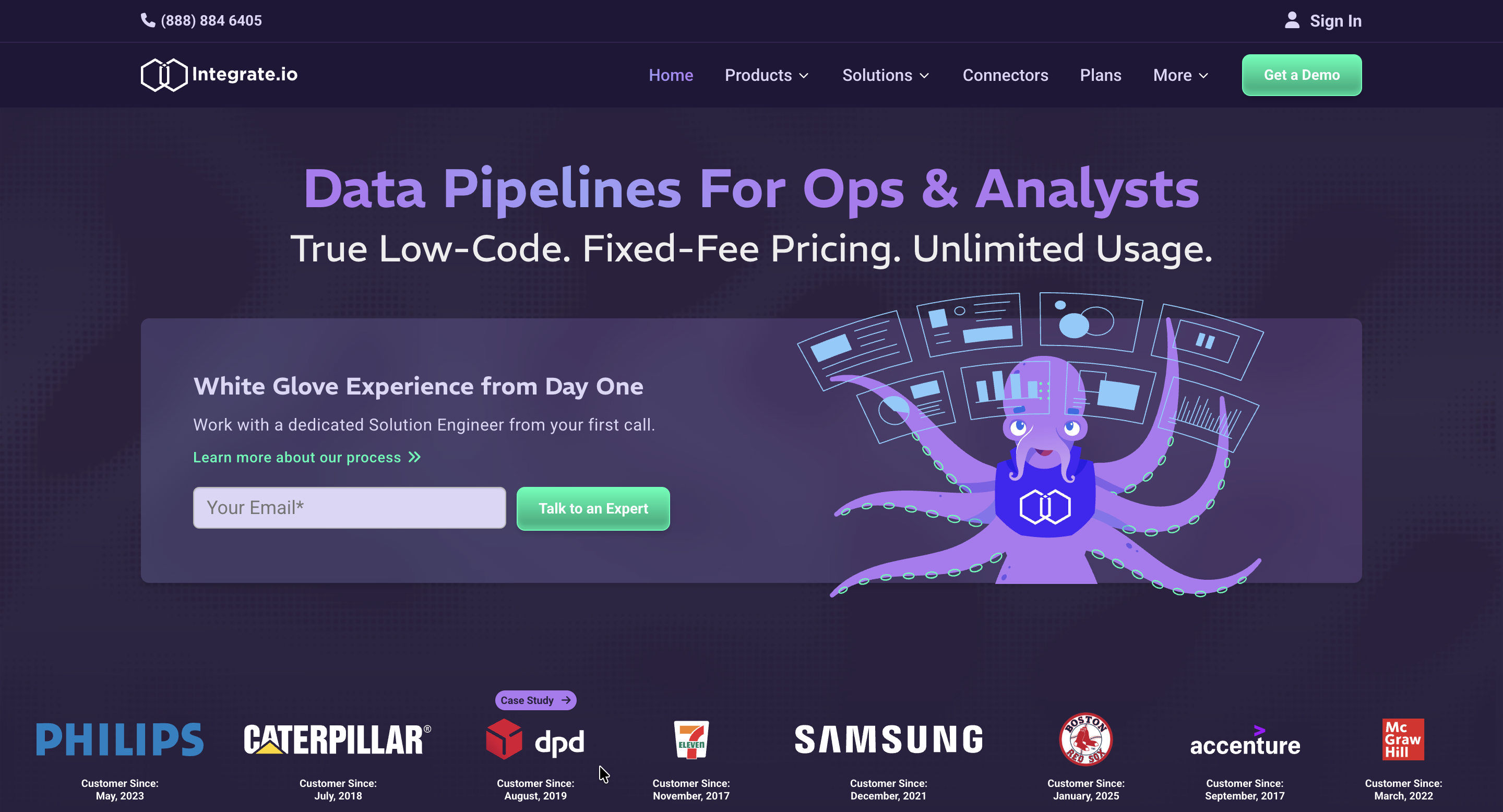
Integrate.io is a cloud-based data integration platform that enables organizations to extract, transform, and load (ETL) data from multiple sources into a centralized system for analytics and operational use.
Key Features:
- ETL & ELT Support: Automates data pipelines for analytics and operational needs.
- Prebuilt Connectors: Quickly connect to databases, SaaS apps, and APIs.
- Data Transformation: Cleanse and structure data as it moves across systems.
Best Fit For: Data-driven enterprises needing ETL pipelines to consolidate, transform, and move data from multiple sources for analytics, reporting, and business intelligence.
6. SAP Data Services
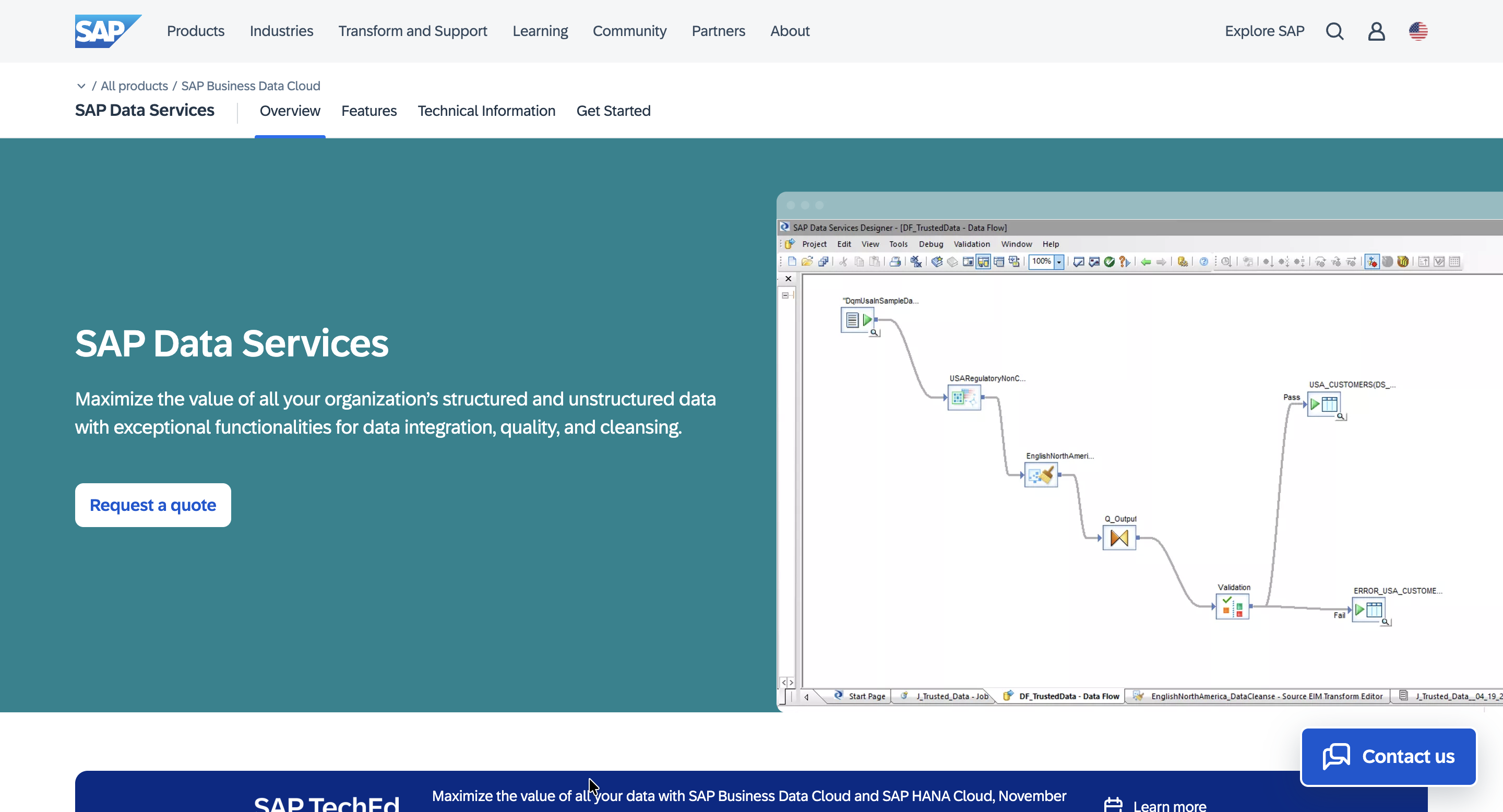
SAP Data Services is an enterprise data integration solution for ETL, data quality, and data governance across SAP and non-SAP systems.
Key Features:
- Comprehensive ETL: Handles complex transformations and workflows.
- Data Quality & Profiling: Cleans and standardizes data for reporting.
- Cross-System Connectivity: Integrates SAP and third-party systems.
Best Fit For: Enterprises needing high-quality, consistent data across systems, with strong data governance, cleansing, and integration capabilities, particularly within SAP-heavy environments.
7. Talend Cloud Data Integration
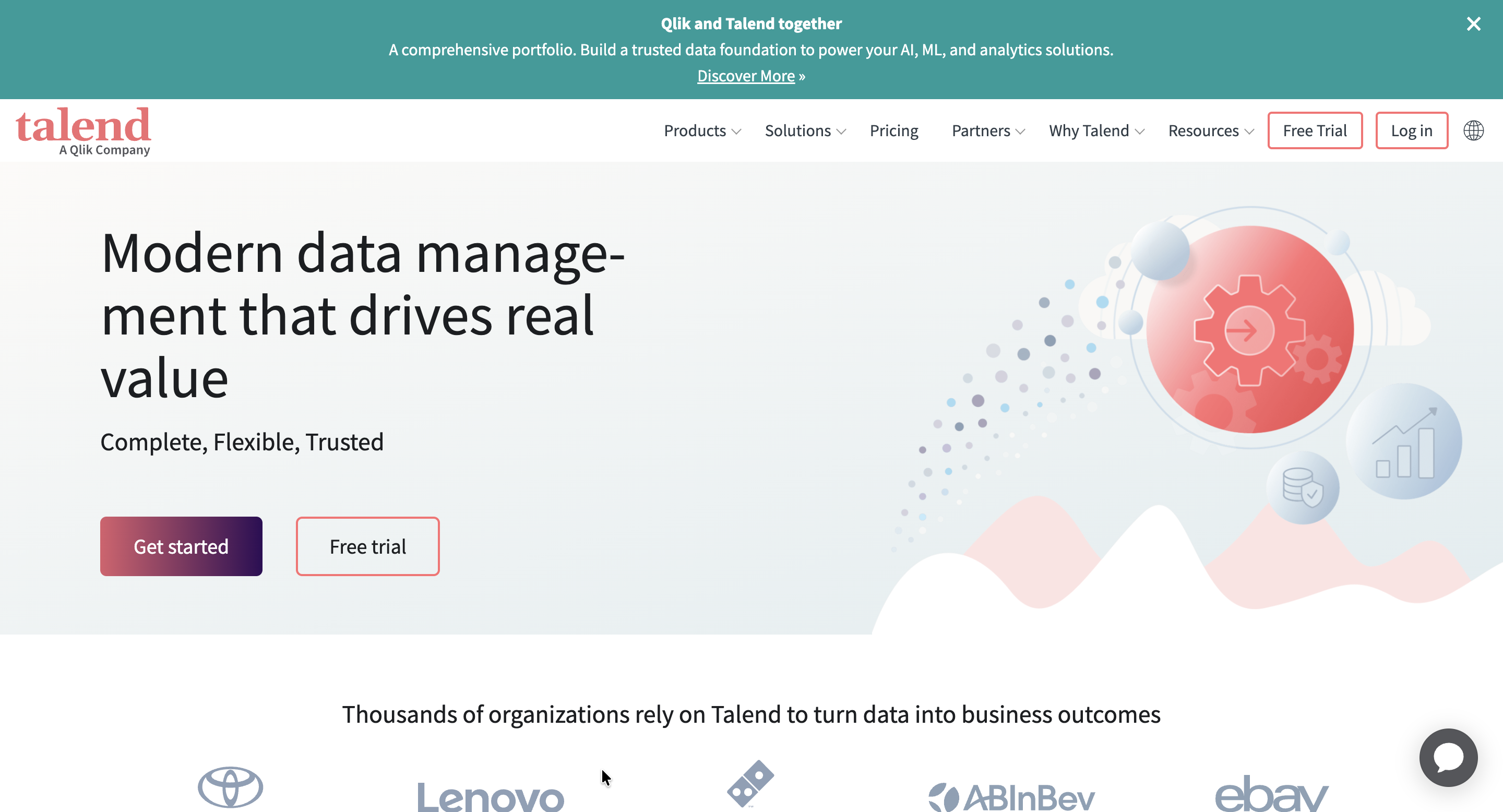
Talend Cloud Data Integration is a unified platform for connecting, transforming, and managing data across cloud and on-premise applications, providing robust data governance and real-time analytics.
Key Features:
- Cloud & On-Prem Integration: Seamlessly connect diverse systems.
- Real-Time Data Processing: Process streaming and batch data efficiently.
- Data Quality & Governance: Built-in tools to ensure reliable, compliant data.
Best Fit For: Enterprises needing robust ETL and data governance for hybrid or cloud environments, ensuring high-quality, compliant, and consistent data across multiple systems in regulated industries like finance or healthcare.
8. Linx
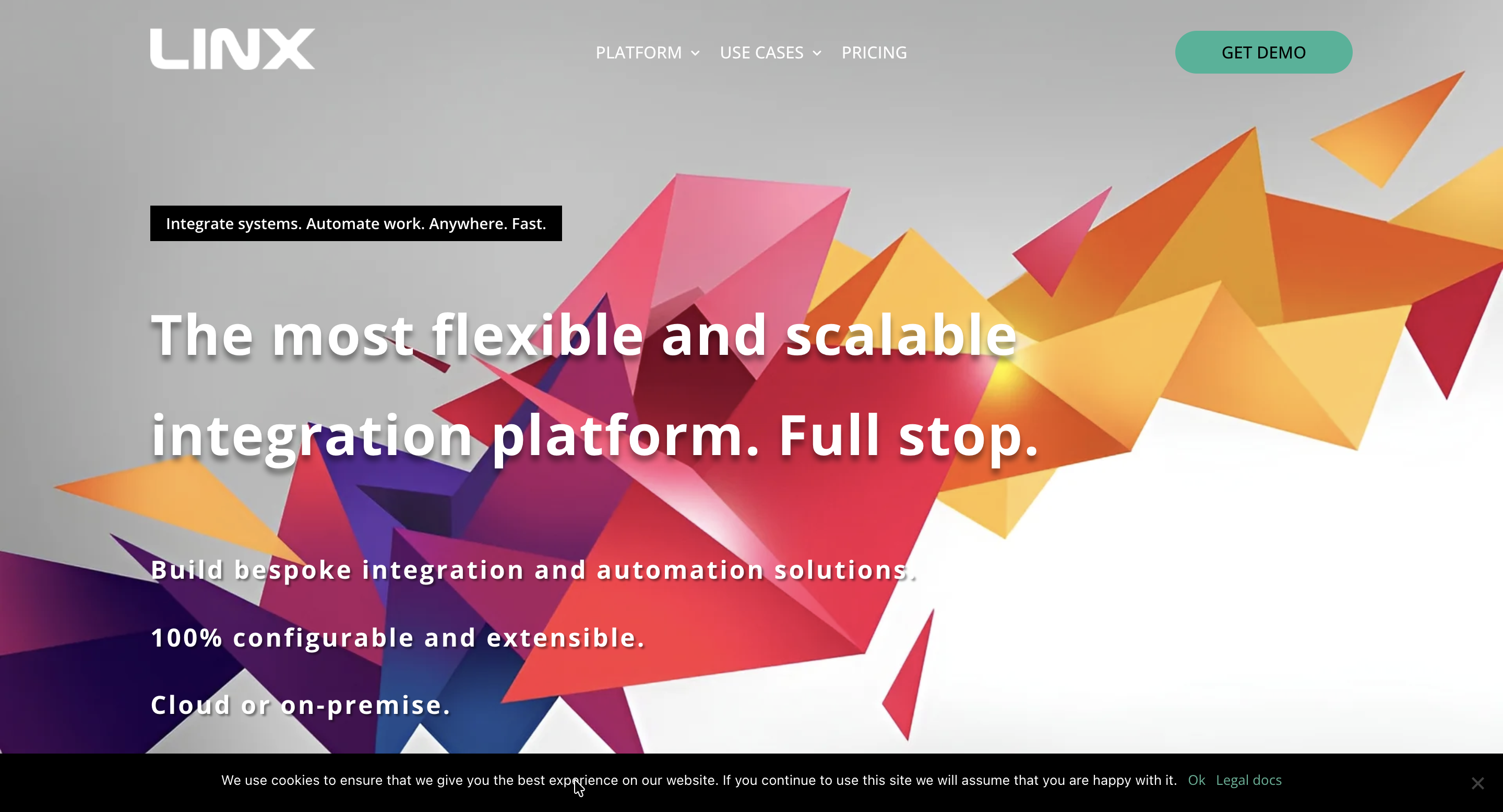
Linx is a low-code platform designed for backend applications, offering businesses a highly flexible and efficient solution for application integration, data synchronization, and API development.
Key Features:
- Backend Automation: Automates backend processes to streamline operations.
- Data Integration: Connects various data sources for unified access.
- API Development: Enables rapid development and deployment of APIs.
Best Fit For: IT and developer teams looking for a low-code platform to rapidly build APIs, automate workflows, and integrate enterprise applications with flexibility and minimal coding effort.
9. Celigo
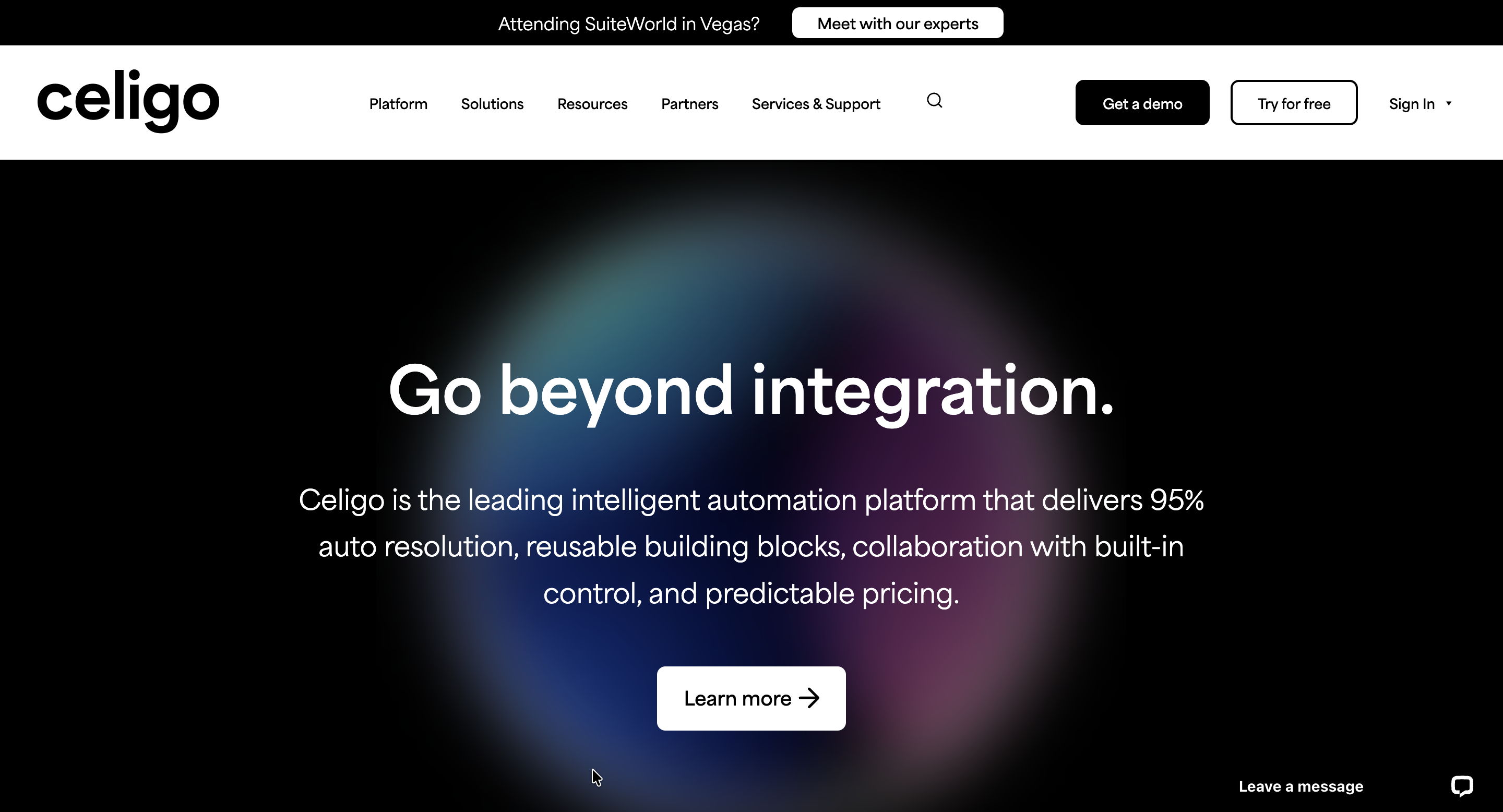
Celigo connects applications, automates workflows, and provides tools for data synchronization, catering to various business needs.
Key Features:
- Application Integration: Connects a wide range of applications for seamless data flow.
- Workflow Automation: Automates business processes to improve efficiency.
- Data Synchronization: Ensures consistent data across integrated systems.
Best Fit For: Growing businesses or mid-market enterprises seeking scalable, pre-built integrations for ERP, CRM, and eCommerce systems, especially NetSuite, to streamline operations without heavy development resources.
10. Boomi
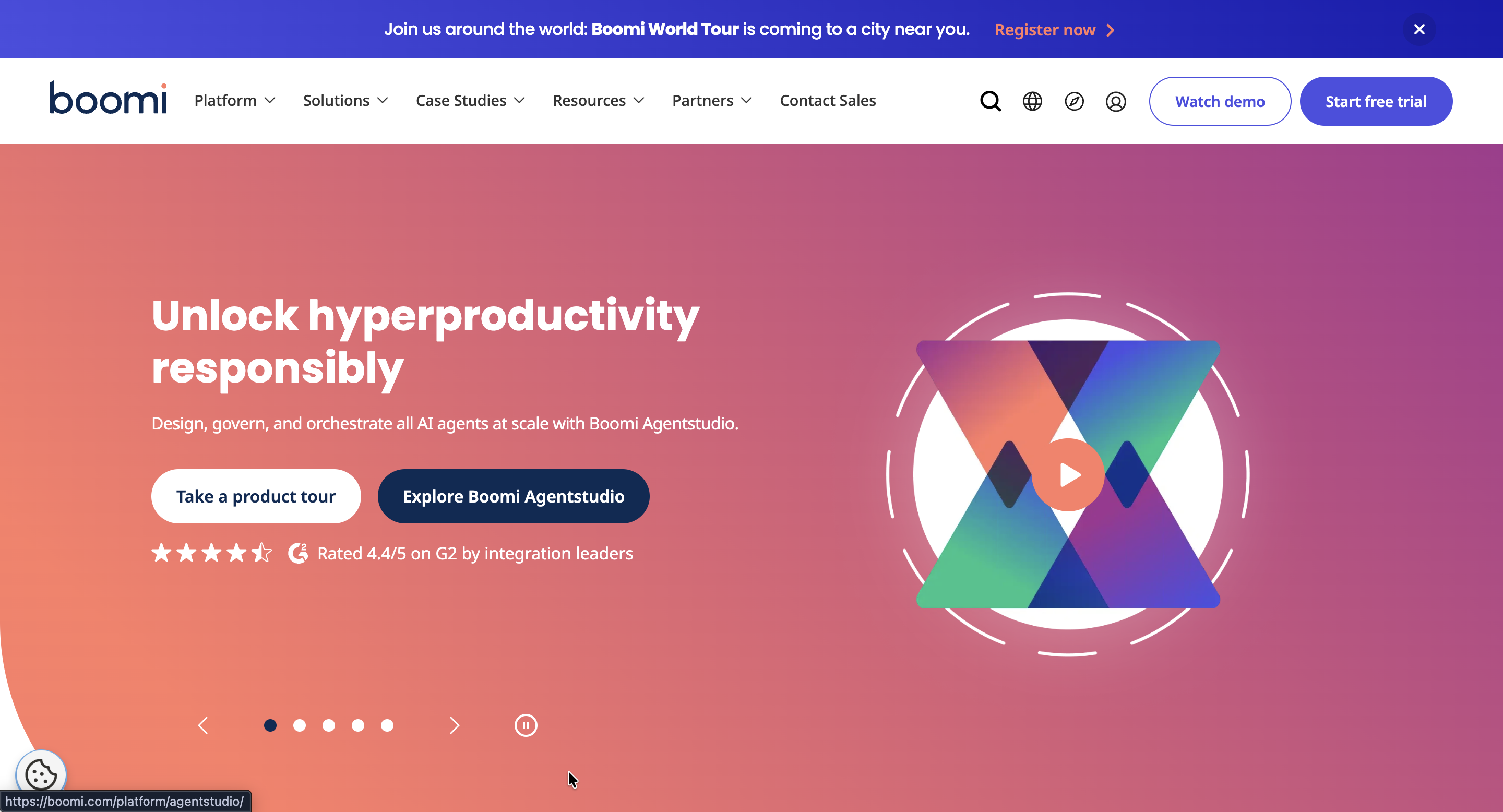
Boomi is a cloud-based integration platform (iPaaS) that connects applications, data, and processes for businesses, supporting both cloud and on-premise environments.
Key Features:
- Low-Code Integration: Visual interface for fast workflow creation.
- API Management: Create, manage, and secure APIs across systems.
- Data Quality & Governance: Monitor and maintain clean, consistent data.
Best Fit For: Enterprises wanting a cloud-native, low-code integration platform to connect apps, automate workflows, and manage APIs across complex hybrid and cloud environments efficiently.
11. Workato
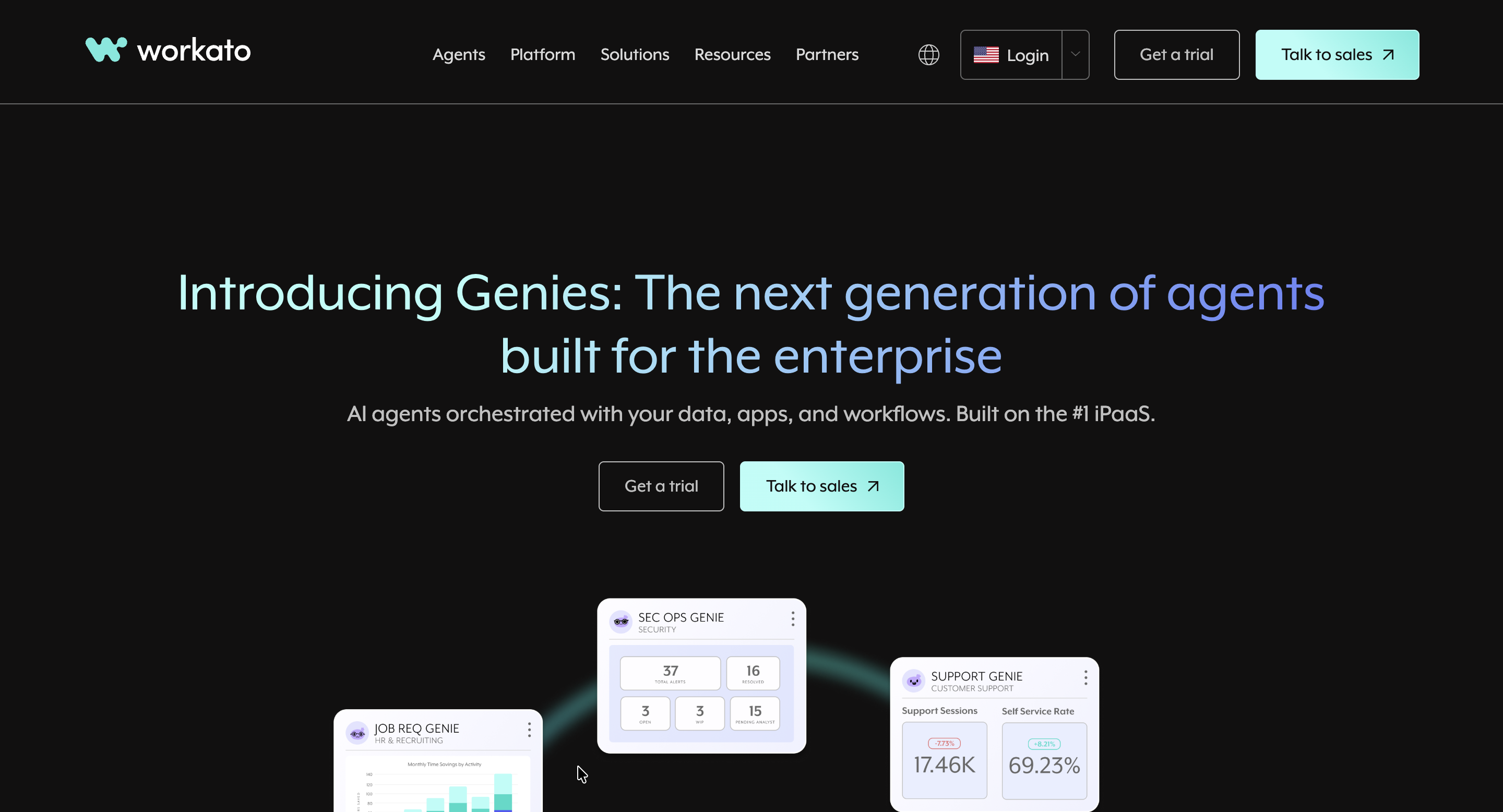
Workato enables integration and workflow automation between cloud and on-premise applications with minimal coding.
Key Features:
- Prebuilt Recipes: Access thousands of ready-made automation templates.
- AI-Driven Workflows: Automate complex processes intelligently.
- Secure Integrations: Enterprise-grade security and compliance for data flows.
Best Fit For: Organizations aiming to automate and integrate cloud and on-premise applications with pre-built connectors, intelligent workflow automation, and drag-and-drop tools for faster deployment and reduced manual effort.
12. MuleSoft
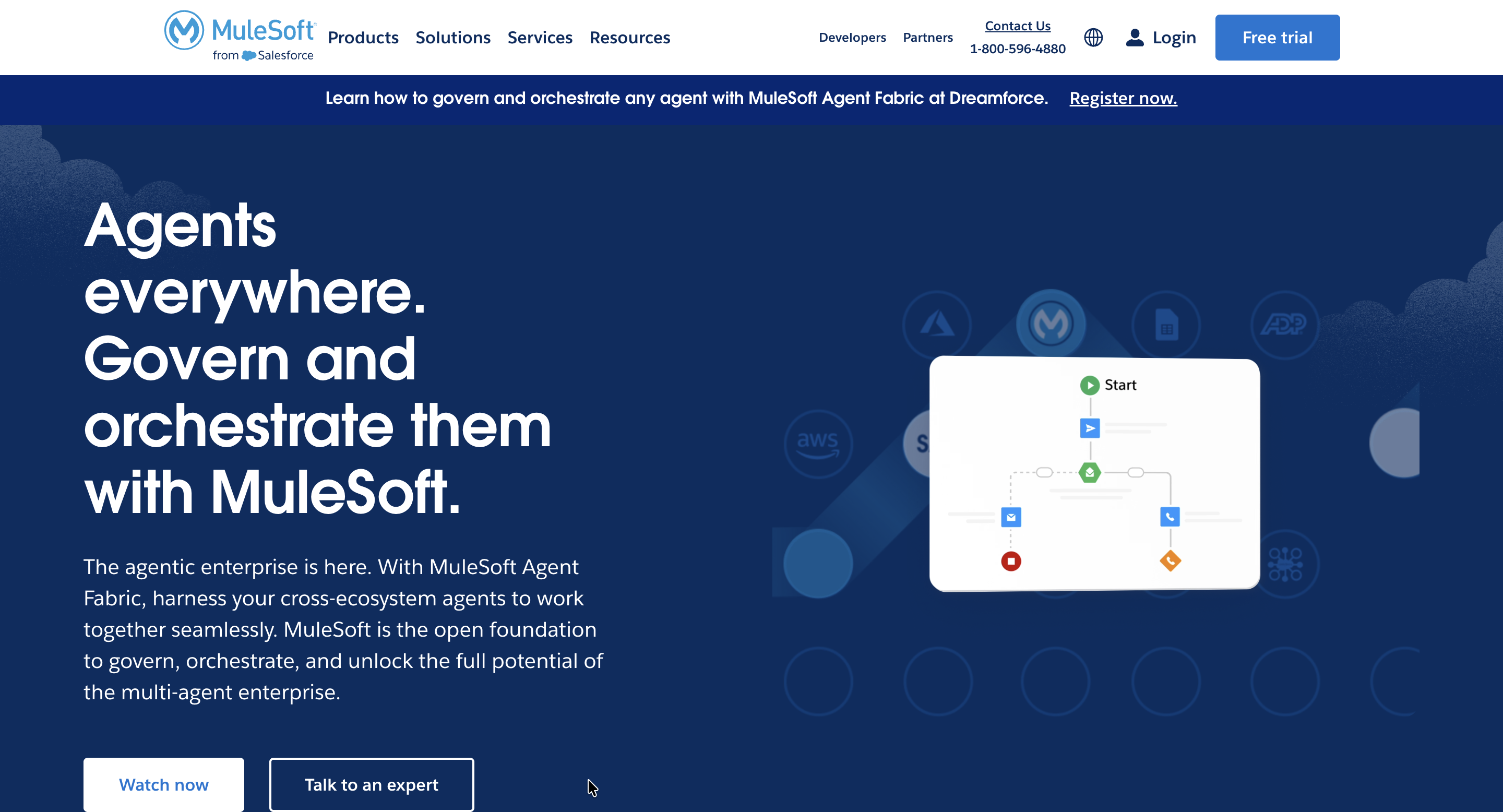
MuleSoft enables organizations to design, manage, and orchestrate APIs and integrations across cloud and on-premise systems.
Key Features:
- API-Led Connectivity: Design and manage APIs for consistent integration.
- Prebuilt Connectors: Accelerates integration with SaaS and legacy systems.
- Monitoring & Analytics: Track performance and troubleshoot integration workflows.
Best Fit For: Large enterprises needing robust API-led connectivity across cloud and on-premise systems, with reusable APIs, secure data flows, and scalable integrations for complex, multi-system environments.
13. Crosscut
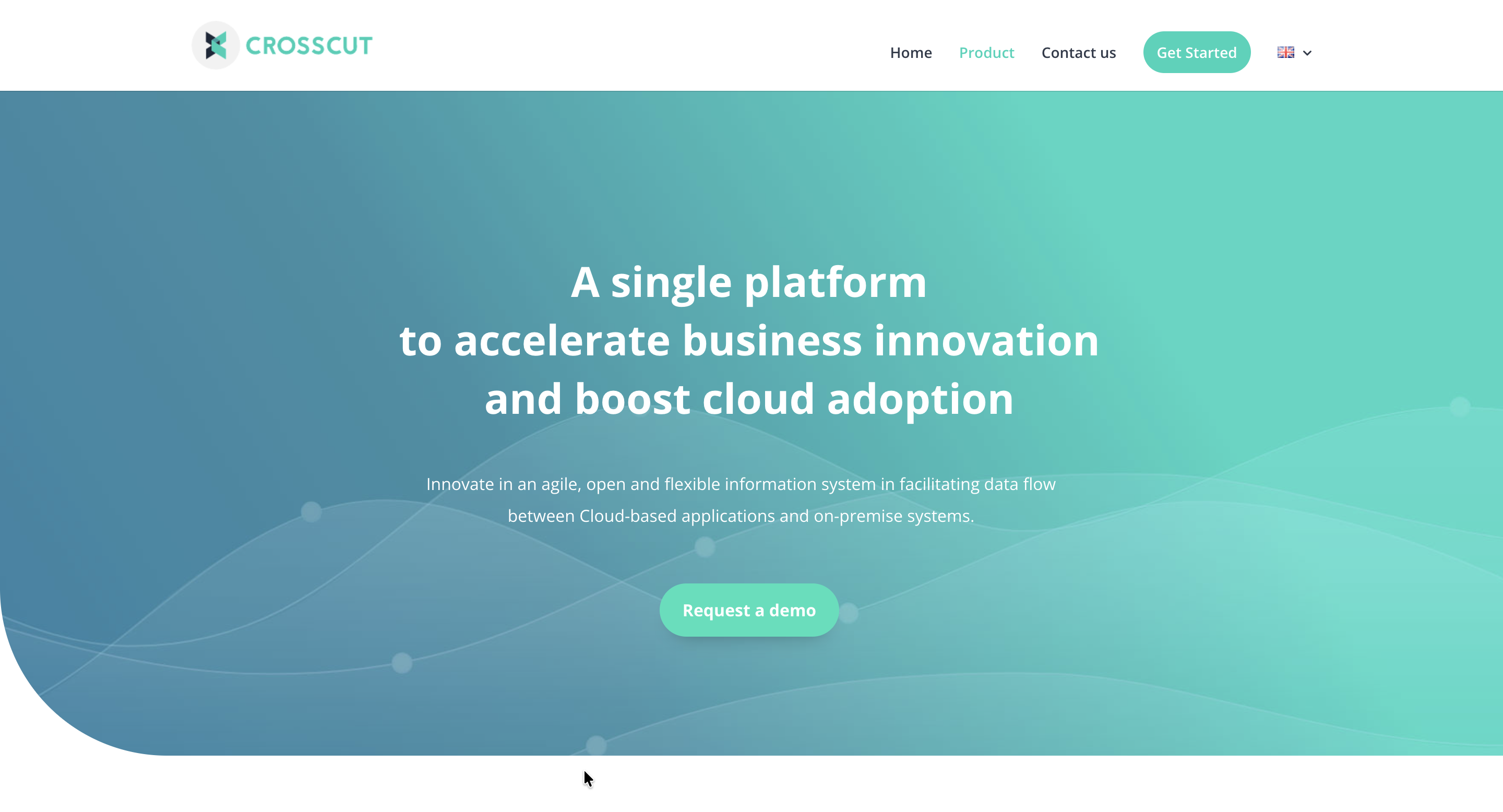
Crosscut helps organizations connect disparate systems, automate workflows, and maintain data consistency across business applications.
Key Features:
- Data Synchronization: Keep data aligned across cloud and on-prem systems.
- Workflow Automation: Automate business processes for efficiency.
- Centralized Monitoring: Monitor integrations in real time for errors and performance.
Best Fit For: Organizations seeking to automate data orchestration and workflow processes across marketing, sales, and finance systems, with low-code tools that simplify integration between disparate platforms.
14. Tray
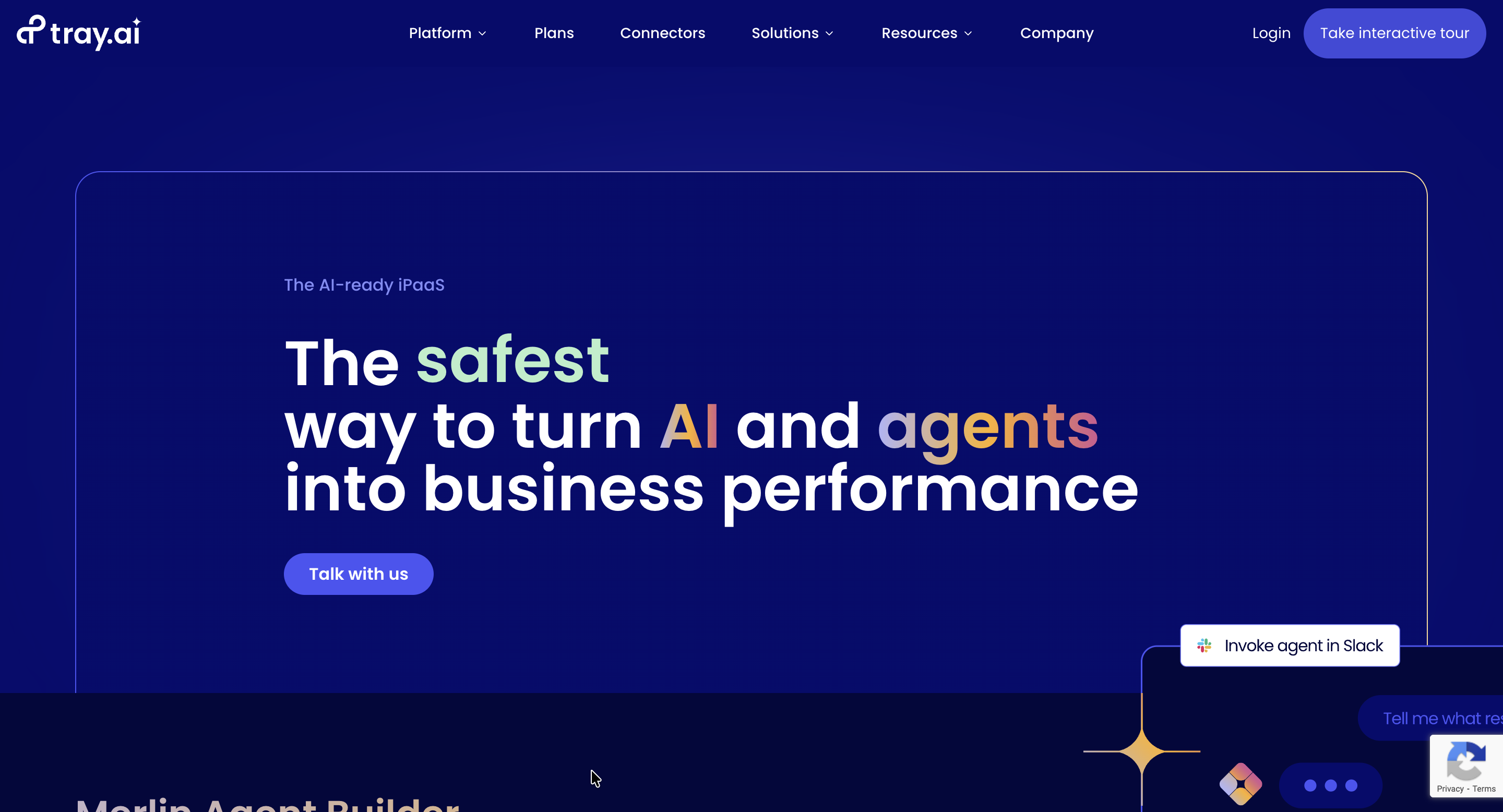
Tray empowers businesses to connect applications, automate processes, and leverage AI capabilities across their tech stack.
Key Features:
- Universal Automation Cloud: Supports AI, integration, and automation initiatives from a single place.
- Merlin Agent Builder: For building and deploying AI agents that can automate tasks across various applications.
- Embedded Integration Solutions: Allows businesses to offer white-labeled integration experiences to their customers and partners.
Best Fit For: Teams looking for a flexible, low-code integration platform to automate SaaS workflows, sync data between applications, and quickly deploy custom connectors for complex business processes.
15. AWS AppSync
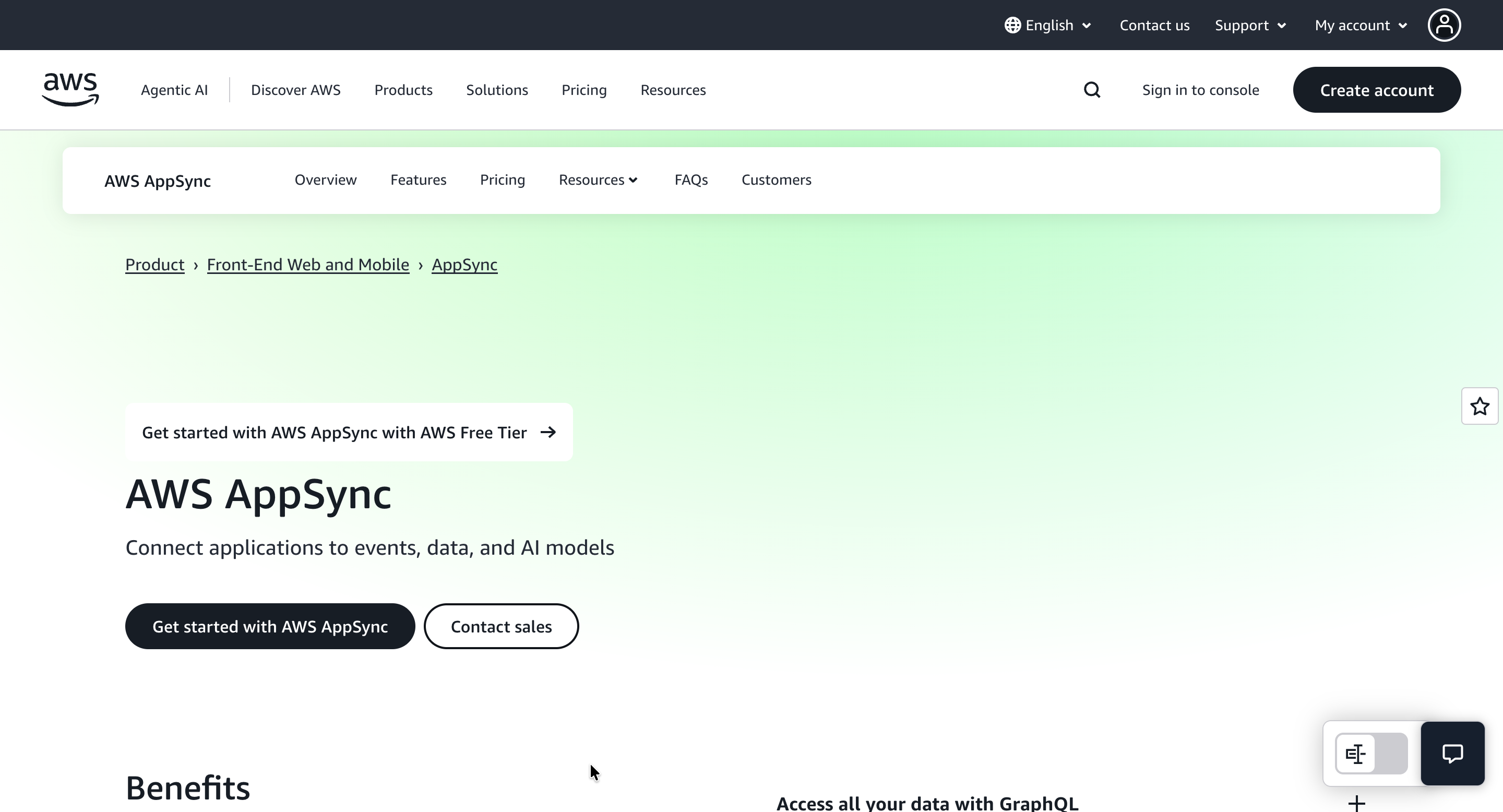
AWS AppSync is a managed service that simplifies application development by securely connecting apps to data sources like databases, APIs, and microservices, supporting real-time updates.
Key Features:
- GraphQL API Management: Efficiently query multiple data sources in one API.
- Real-Time Data Sync: Keeps apps and users updated automatically.
- Scalable Infrastructure: Handles complex queries and high-volume operations.
Best Fit For: Enterprises building real-time applications that require seamless data integration via GraphQL, enabling secure, scalable APIs across multiple data sources and improving app performance.
16. Oracle Data Integrator
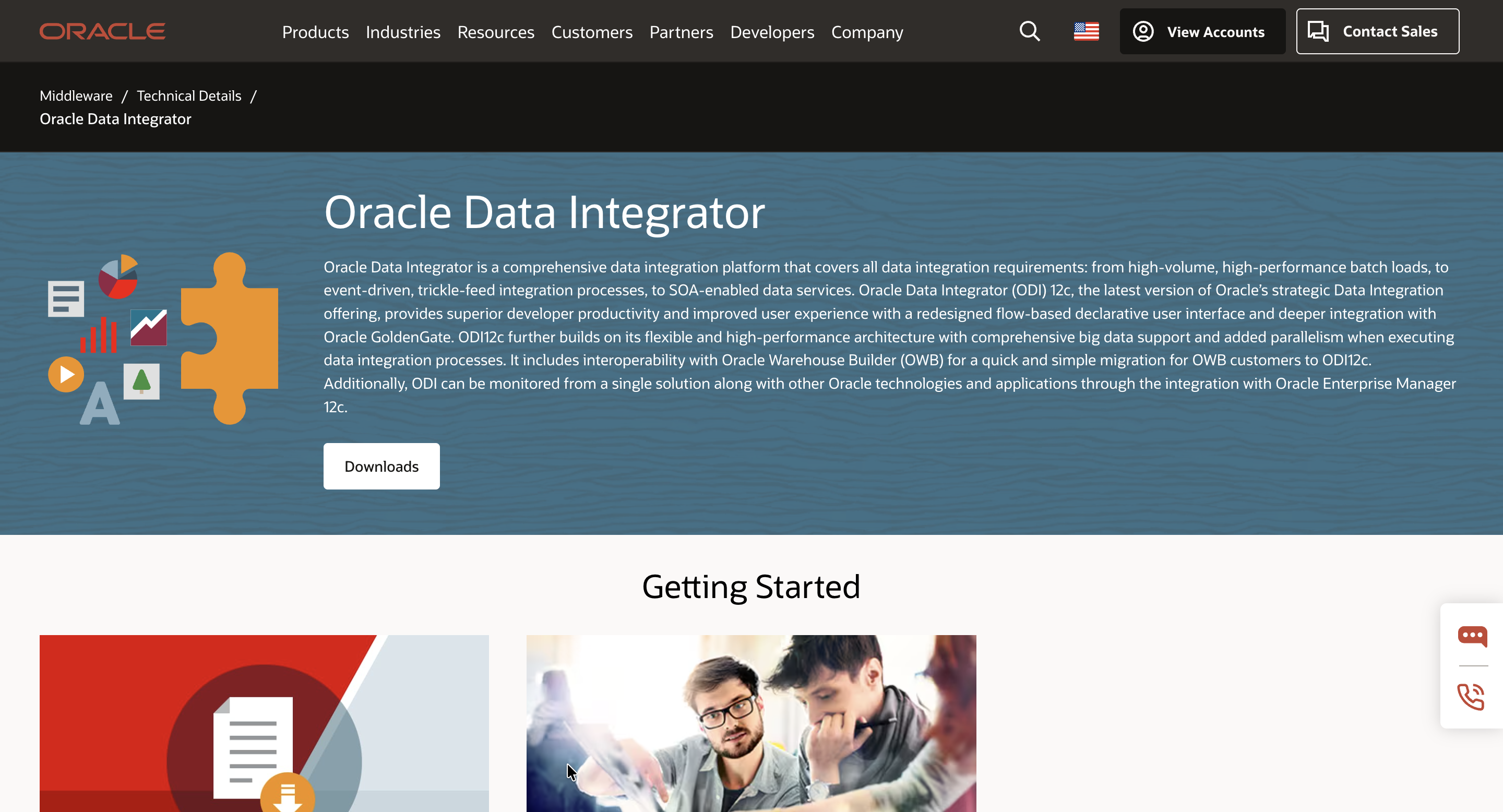
Oracle Data Integrator (ODI) is a comprehensive data integration platform for high-performance ETL, data transformation, and loading across heterogeneous systems.
Key Features:
- Declarative Design: Simplifies complex data transformations.
- Bulk Data Movement: Optimized for high-volume data transfers.
- Enterprise Connectivity: Supports on-premise and cloud applications.
Best Fit For: Organizations with large Oracle environments needing high-performance ETL, batch data movement, and transformation capabilities to maintain consistent, high-quality data across complex enterprise systems.
17. TIBCO Platform
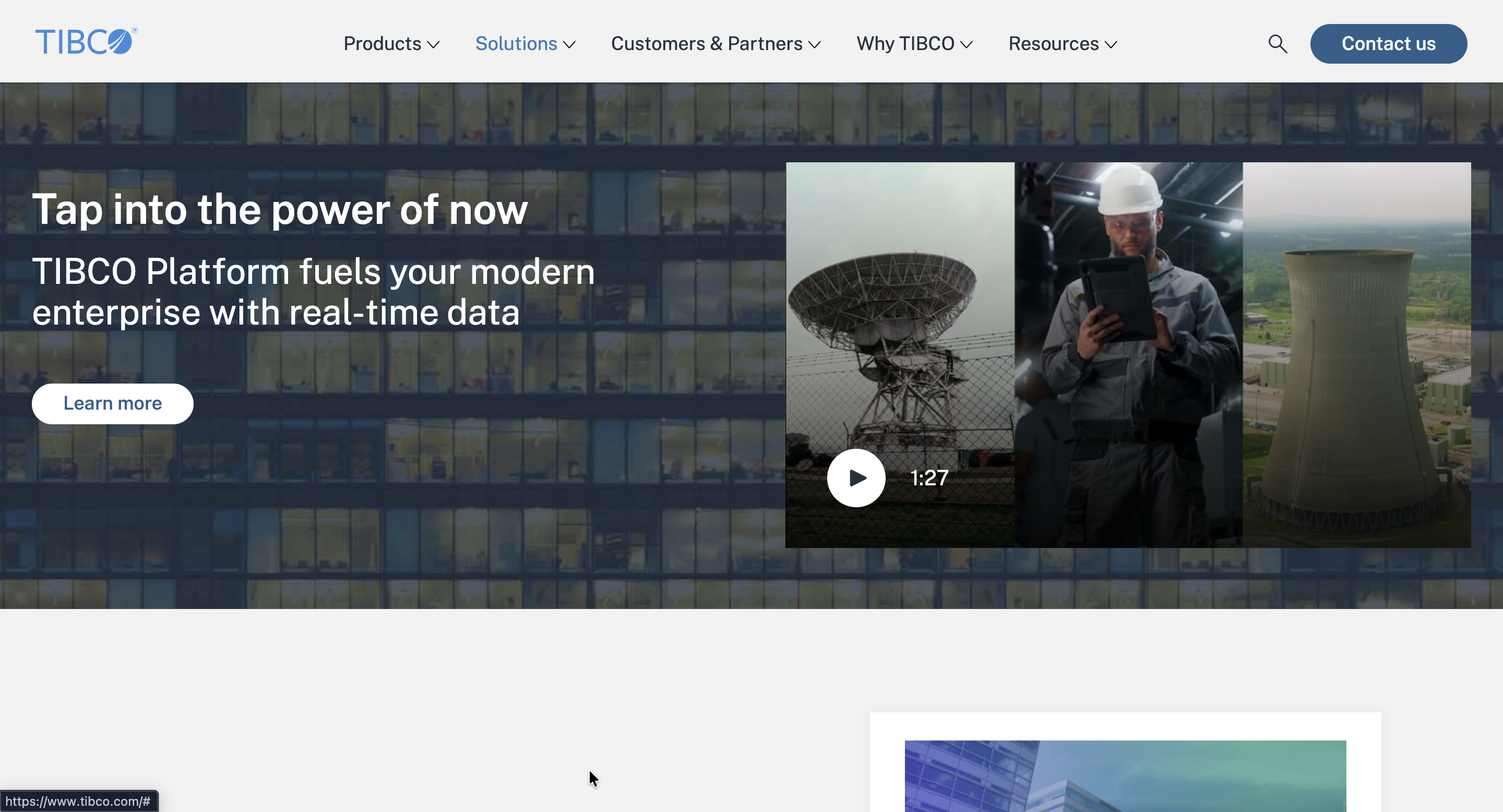
TIBCO Platform connects cloud and on-premise applications, enabling seamless data flow and automated business processes across the enterprise.
Key Features:
- API & Event Management: Build, deploy, and monitor APIs and event-driven workflows.
- Prebuilt Connectors: Quickly integrate popular applications and systems.
- Visual Workflow Designer: Design integrations with drag-and-drop simplicity and low-code tools.
Best Fit For: Enterprises needing real-time data integration and event-driven automation across applications, enabling fast decision-making, scalable workflows, and connectivity between cloud, on-premise, and legacy systems.
18. Alumio
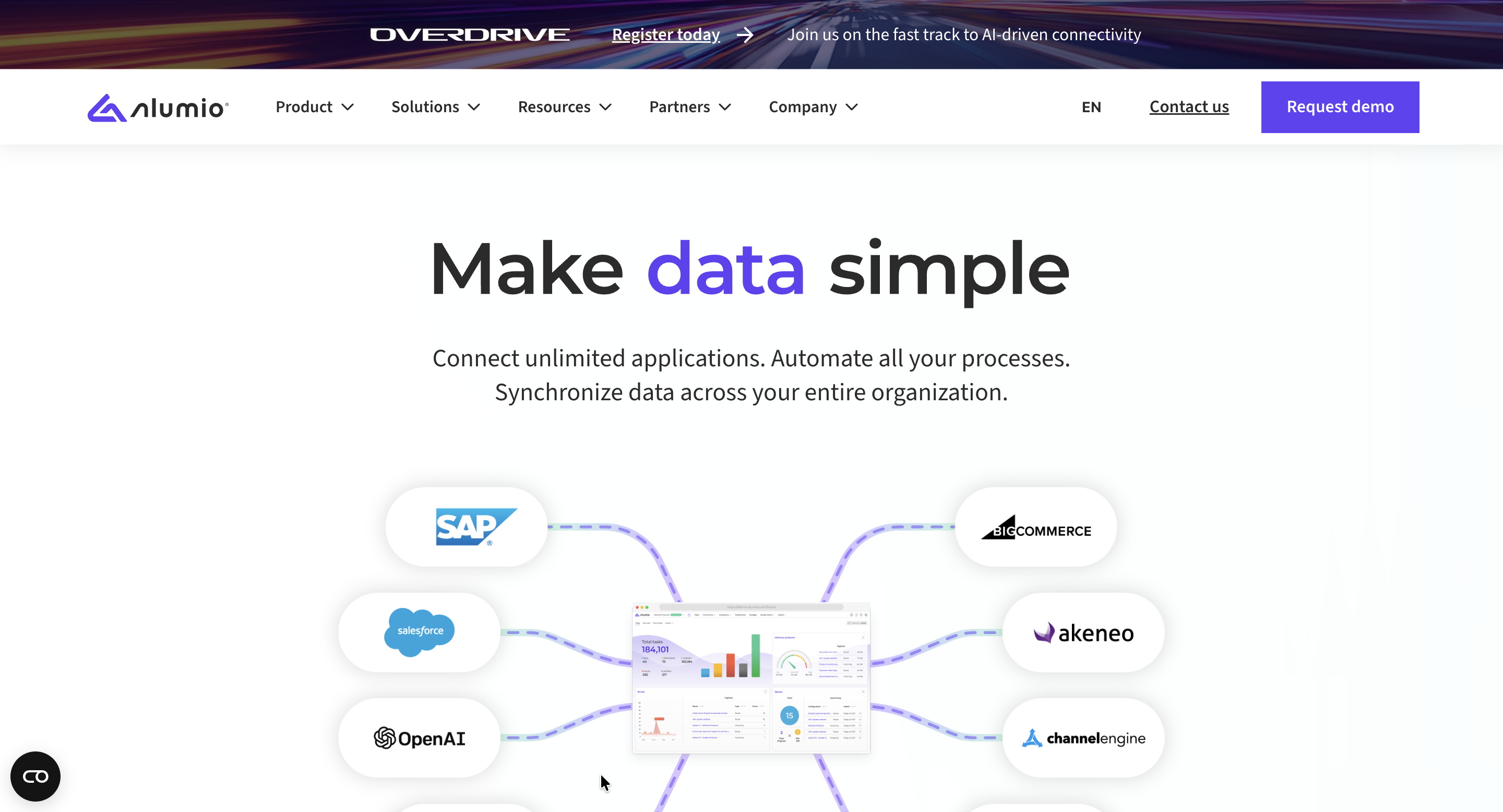
Alumio is a cloud-based integration platform that provides tools for connecting applications, automating workflows, and synchronizing data across systems, catering to enterprise needs.
Key Features:
- Cloud Integration: Facilitates seamless integration of cloud applications.
- Data Synchronization: Ensures consistent data across integrated systems.
- Workflow Automation: Automates business processes to enhance efficiency.
Best Fit For: B2B organizations looking for a low-code, API-first platform to build, manage, and scale integrations between ERP, CRM, eCommerce, and other enterprise systems efficiently.
19. Exalate
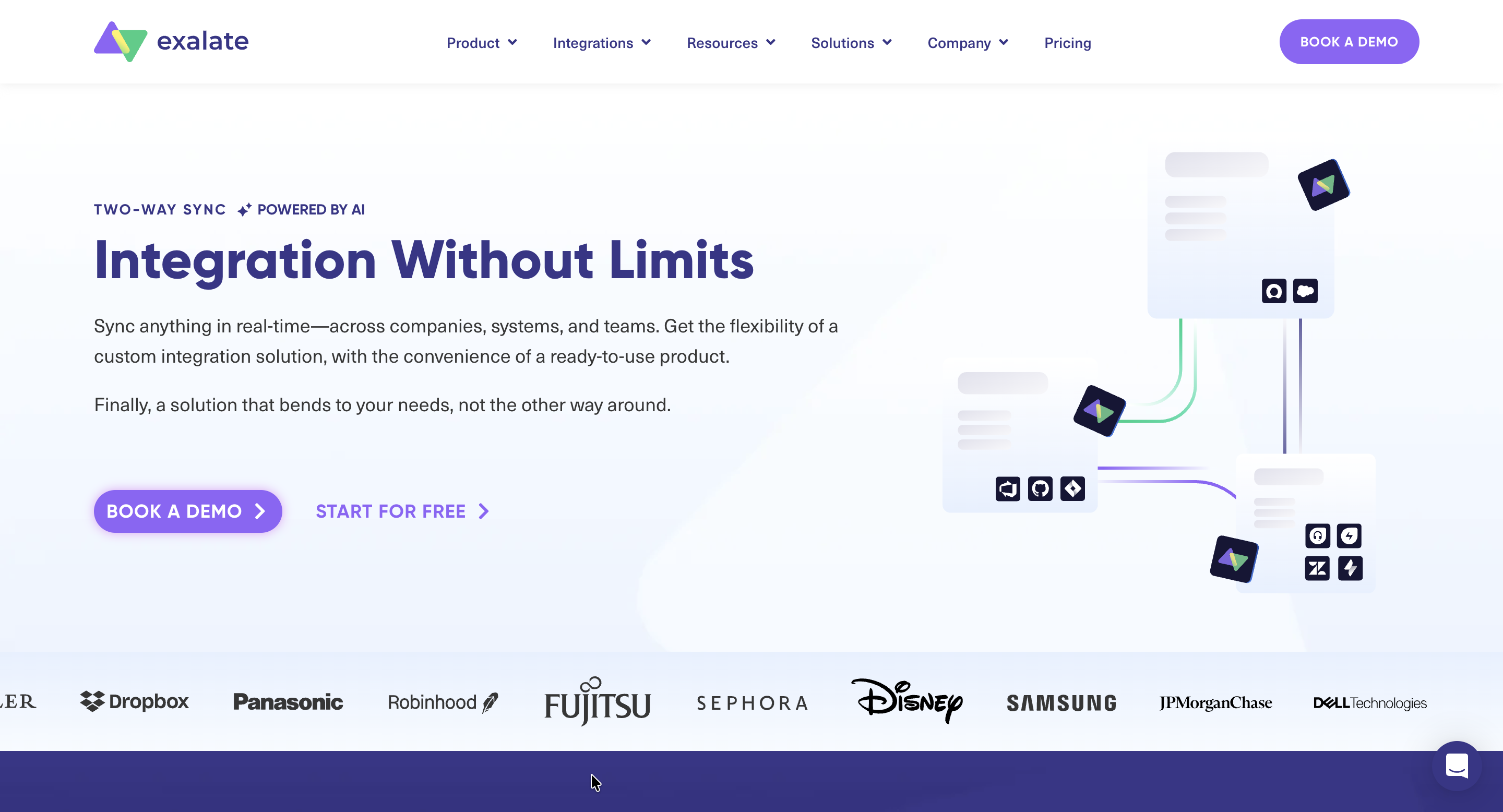
Exalate enables issue and project synchronization across different systems such as Jira, ServiceNow, and GitHub, keeping teams aligned across tools.
Key Features:
- Cross-Platform Sync: Seamlessly sync issues and projects across systems.
- Customizable Rules: Configure synchronization to match workflow needs.
- Secure & Auditable: Ensures data privacy and traceable sync operations.
Best Fit For: Teams requiring secure, bi-directional issue and project synchronization across multiple platforms (e.g., Jira, ServiceNow, GitHub) to maintain collaboration and data consistency in distributed environments.
20. Frends
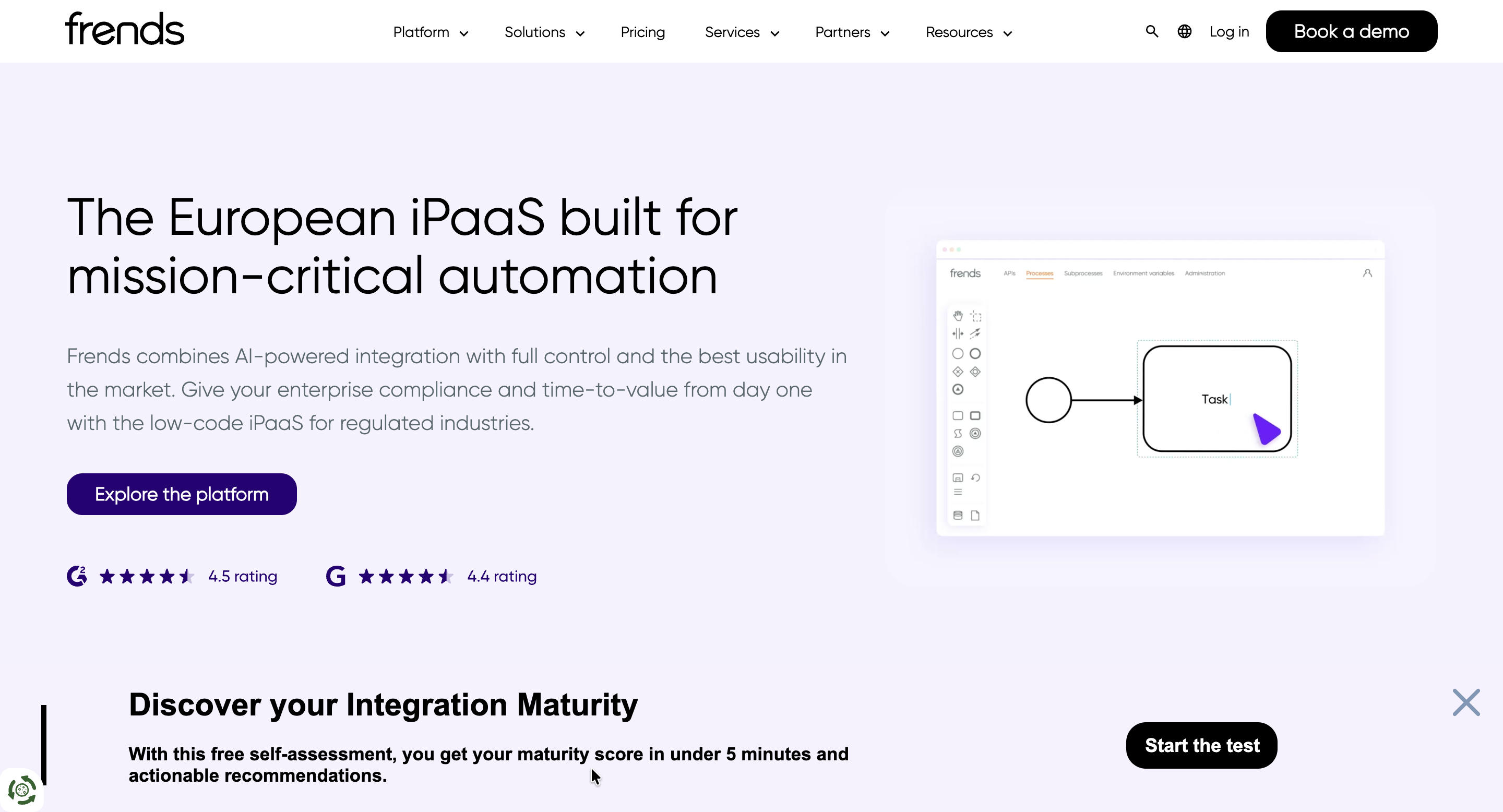
Frends is a hybrid integration platform that connects applications, APIs, and data across systems, enabling businesses to automate workflows and streamline operations.
Key Features:
- Hybrid Integration: Supports both cloud and on-premises integration scenarios.
- API Management: Provides tools for creating, managing, and securing APIs.
- Workflow Automation: Automates business processes to improve efficiency.
Best Fit For: Enterprises seeking a low-code integration and workflow automation platform to connect applications, automate processes, and orchestrate APIs across complex hybrid environments.
Suggested Read: API vs Integration: The Differences and Intersections
How to Evaluate an Integration Platform Before You Commit
The right platform should reduce complexity, provide reliable governance, and support your team’s workflow without introducing new bottlenecks.
Here’s what to focus on:
1. Aligns with Your Architecture and Scale
Assess whether the platform fits your existing tech stack and future roadmap. Can it handle multiple apps, high transaction volumes, or global deployments without slowing down processes? Consider flexibility for adding new systems as your business grows.
2. Supports Enterprise-Level Governance and Compliance
Look for platforms that enforce data consistency, logging, audit trails, and compliance standards (GDPR, SOC 2, HIPAA). Strong governance reduces operational risk and ensures your integrations withstand internal and external audits.
3. Delivers Measurable Operational Impact
Focus on platforms that demonstrably reduce manual workflows, improve data accuracy, and accelerate critical processes like employee onboarding, payroll reconciliation, or cross-system reporting. Senior stakeholders need to see tangible ROI, not just features.
4. Minimizes Technical Debt and Maintenance Burden
Evaluate long-term maintainability. Can your team monitor, troubleshoot, and update integrations without constant engineering intervention? Platforms with reusable connectors, prebuilt templates, and centralized dashboards reduce ongoing support overhead.
5. Provides Transparent SLAs and Vendor Reliability
Ensure uptime, support responsiveness, and upgrade policies are clearly defined. Experienced teams need confidence that the platform won’t introduce operational risk if a system changes or experiences downtime.
6. Cost Structure Matches Usage and Growth
Examine pricing models carefully—per connection, per volume, or per feature. The goal is predictable, scalable costs that align with business growth without hidden fees or long-term lock-ins.
Seamless Enterprise Integration Starts Here
Integration doesn’t have to be a headache. With the right platform, your systems sync automatically, workflows stay consistent, and your teams spend less time troubleshooting and more time focusing on growth initiatives.
Bindbee simplifies complex enterprise stacks with one unified API, real-time data flow, and no-code monitoring. Book your demo today to see how our integrations run without friction or constant oversight.
FAQs
1. What is an integration platform?
An integration platform connects different software systems so they can share data and work together automatically. It removes manual tasks, keeps information consistent, and lets teams manage complex workflows without constant developer involvement.
2. What are the four types of system integration?
The four main types are point-to-point integration, vertical integration, star integration (hub-and-spoke), and horizontal integration (middleware or iPaaS). Each approach varies in complexity, scalability, and suitability depending on the number of systems and workflow requirements.
3. Why do enterprises need integration platforms?
Enterprises juggle multiple applications like HRIS, CRM, ERP, and payroll. Integration platforms streamline these connections, reduce errors, cut down on manual work, and let teams scale operations efficiently without overloading engineering resources.
4. What are some examples of integration platforms?
Popular integration platforms include Bindbee, MuleSoft, Zapier, and Boomi. These tools enable automated workflows, real-time data sync, and low-code or no-code integration, helping enterprises connect multiple systems without relying on custom scripts or manual reconciliation.
5. How do integration platforms improve workflow efficiency?
Integration platforms automate repetitive processes, synchronize data across systems, and provide dashboards for monitoring health. Teams spend less time correcting errors or manually transferring information and more time on strategic initiatives, improving productivity and operational reliability.
6. What should enterprises consider when choosing an integration platform?
Enterprises should look for scalability, security, and compliance support, as well as ease of use and vendor reliability. Platforms should integrate smoothly with existing systems, reduce technical overhead, and provide monitoring tools without creating additional complexity.





